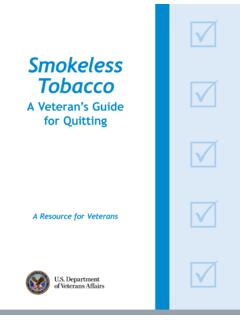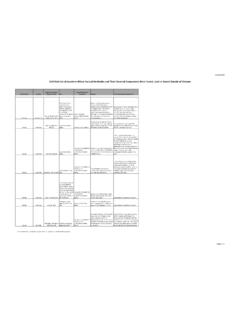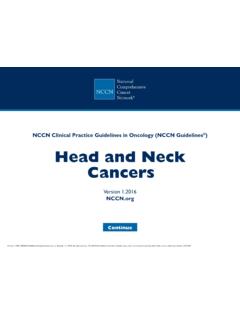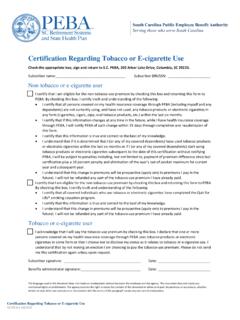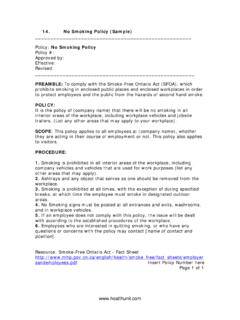Transcription of Tobacco Cessation: An Abbreviated Mini-Workbook A …
1 To b a c c o cessation : An Abbreviated Mini-Workbook A Resource for VeteransTable of ContentsCHAPTER 1: Introduction ..1 CHAPTER 2: Why Do I Use Tobacco ? ..3 CHAPTER 3: Nicotine Addiction ..6 CHAPTER 4: Medications To Help You Quit Tobacco ..11 CHAPTER 5: Getting Ready For Quit Day! ..12 CHAPTER 6: Quit Day ..18 CHAPTER 7: The First Two Weeks After Quit Day ..21 Tobacco cessation Resources ..23 Appendix A ..24 This Mini-Workbook is an Abbreviated version of the Tobacco & Health Primary Care Tobacco cessation program book My Tobacco cessation workbook . It is intended to be used by Veterans involved in telephone, telehealth, or secure message-based Tobacco cessation programs. Veterans prescribed Tobacco cessation medications should be given individual medication handouts as this Mini-Workbook does not contain in-depth medication information.
2 Download patient medication guides here: Department of Veterans AffairsVeterans Health AdministrationWashington, DC 20420 Tobacco cessation : An Abbreviated Mini-Workbook July 201511 CHAPTER 1: IntroductionCHAPTER 1: IntroductionCongratulations on taking the first step to quitting Tobacco products. Whether you smoke cigarettes, cigars, pipes or use chewing Tobacco , VA s Primary Care Tobacco cessation Program can help you quit. smoking is the number one cause of preventable illness in the United States. smoking increases your chance of having a heart attack and stroke and it can damage your lungs and in many cases, lead to emphysema. smoking can also cause cancer of the lungs, bladder, kidney, and pancreas as well as cause cancer in the mouth and throat.
3 If you have tried to quit before and have not been successful, don t give up! Research has shown that it takes an average of 6-8 quit attempts for a smoker to quit for good. Think of Tobacco dependence as a chronic disease like high blood pressure or high will need to work at it to become a nontobacco user. So what is the best way to quit Tobacco ? People ask this question all the time and there are multiple ways you can stop. The best way to stop Tobacco is to use behavioral techniques to help you break the habit and develop new behaviors, along with medications to help you manage nicotine withdrawal symptoms. This Mini-Workbook , written specifically for Veterans, will assist you in changing your daily behaviors that up until now have resulted in your use of Tobacco 1: IntroductionWHY DO I WANT TO QUIT Tobacco ?
4 The first step in quitting any addictive drug, including nicotine, is to determine why you want to off the reasons you want to quit Tobacco products: Breathe better Reduce my risk of cancer Reduce my risk of heart attack and stroke Improve circulation of blood to my legs and arms Reduce my risk of emphysema/chronic bronchitis, chronic obstructive pulmonary disease (COPD) Smell better Improve my sense of smell and taste Save money Set a good example for my children/grandchildren Have more control over my lifeWhat are other reasons you want to quit? Write these reasons below:_____3 CHAPTER 2: Why Do I Use Tobacco ?CHAPTER 2: Why Do I Use Tobacco ? Tobacco USE IS LINKED TO OTHER HABITST obacco use is associated with several different behaviors that are very closely related.
5 Tobacco use is a learned behavior, meaning you learned this from your family, friends, magazine ads, television, movies, or during your military service. When you were in the military, you may have heard someone say Smoke em if you got em. Who helped you learn your Tobacco habit?Think about how often you puff or drag on a cigarette in a day. If you smoke one pack of cigarettes a day and each cigarette takes 10 puffs, that s 200 puffs a day. Over the course of 40 years, you would take approximately three million puffs! Tobacco use is also a triggered behavior, meaning certain activities or times of day may make you think about having a cigarette or chewing off some of your triggers for using Tobacco : Waking up in the morning Waking up during the night, having nightmares After meals Stress During breaks Pain Driving Feeling anxious, angry or impatient Talking on the phone Seeing someone else smoke Working on the computer Feeling bored Drinking coffee Watching TV Drinking alcohol After completing a task After sex Before bedtimeWrite down other triggers you may have:_____CHAPTER 2: Why Do I Use Tobacco ?
6 A CHALLENGE FOR YOU: ADDRESSING YOUR TRIGGERSTry not smoking during one of your triggers. For example, you might pick after eating breakfast as the trigger. Starting tomorrow, try not smoking for 10 minutes after breakfast. Wait 20 minutes to smoke after breakfast the next day. Wait 30 minutes the day after that. Add another 10 minutes each day. By the end of the week you will be waiting one hour between the trigger and smoking . Once you have tackled one trigger, try adding another trigger until you have a few of them managed. By adding time between the trigger and the action of using Tobacco , the trigger becomes weaker. This will help when you get to your quit day.
7 If you use chewing Tobacco , you can do the same thing by looking at your triggers to put in a new dip. To help you avoid using Tobacco , come up with a few things you can do rather than use Tobacco . Some examples would be: Going for a walk Using a substitute like chewing gum or candy Doing deep breathing exercises (see Appendix A)A more complete list of substitute behaviors can be found under DEADS Strategy on down 3 of your triggers and what you will do instead of using Tobacco :1. Tr igger: _____ Instead of using Tobacco , I will: _____ _____2. Tr igger: _____ Instead of using Tobacco , I will: _____ _____3. Tr igger: _____ Instead of using Tobacco , I will: _____ _____Lastly, Tobacco use is also an automatic behavior, meaning you may find you smoke without thinking about it.
8 You may recall times when you lit a cigarette and then noticed you already had one 2: Why Do I Use Tobacco ?There are a few ways to help reduce this automatic behavior:Tip #1 Move your Tobacco to a different location If you carry your cigarettes in your front pocket, put them on the kitchen counter. If you smoke outside, take one cigarette with you instead of the whole pack. You will need to physically walk to the pack to smoke the next cigarette. This leads you to think about smoking that cigarette and possibly consider whether you really need it or if you can wait longer to have the next one. If you use chewing Tobacco , try placing the can on the kitchen counter or another location in the house, rather than in your pocket.
9 You will need to walk to the location of the Tobacco can before putting in a new plug of #2 Keep track of your cigarettes as you smoke them Track your Tobacco use on a sheet of paper you keep in your pocket or in your pack of cigarettes. Each time you smoke or dip, note on your tracker the time of day, your mood at that time ( , happy, bored, angry, etc.) and your level of need for Tobacco ( , low, medium, high). Keeping track of the cigarettes helps you work on the automatic behavior of smoking . You can see if changes in your mood cause you to smoke more or less. Many people find that they smoke more when they are unhappy, while others might find they smoke more when they are bored.
10 Times of celebration may be a situation when your Tobacco use might increase. You may find that you smoke more when you are around certain friends who also smoke. If you use chewing Tobacco , you can use the same method to track the number of dips you take in a day. CHAPTER 3: Nicotine AddictionCHAPTER 3: Nicotine AddictionWHAT IS NICOTINE?Nicotine is a substance found naturally in Tobacco that causes feelings of pleasure, relaxation or stimulation, and stress reduction. Nicotine is the addictive part of Tobacco , but is not by itself harmful to your body. The other substances found in Tobacco and substances formed when Tobacco is burned harm your body. There are more than 7,000 chemicals in Tobacco smoke and at least 69 that are harmful to humans and can cause cell damage, cell death and cancer.







